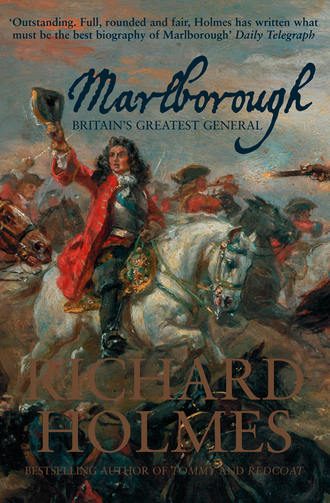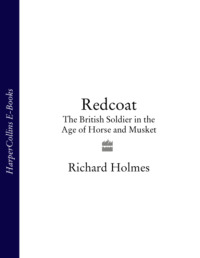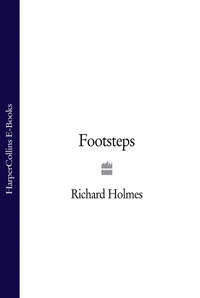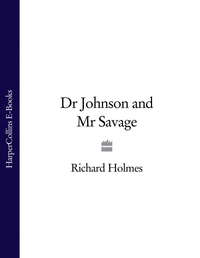
Полная версия
Marlborough: Britain’s Greatest General
These were uncertain times for everyone, and downright difficult ones for those who had demonstrably been on the wrong side in the recent Civil War. Fate chose this unpropitious moment to provide a son for a West Country gentleman called Winston Churchill, sometime captain of horse in the king’s army, and his wife Elizabeth. They named him John, for his paternal grandfather.
Winston and Elizabeth had married across the jagged political divide of the 1640s. John Churchill the elder was a prosperous lawyer, a member of the Middle Temple, and Deputy Registrar of Chancery before the Civil War, who had bought an estate at Newton Montacute in the parish of Wootton Glanville, near Sherborne in Dorset. Aged about sixty, he was too old to be in arms, but like Robert Browning’s ‘Kentish Sir Byng’ he ‘stood for his king/bidding the cropheaded Parliament swing’ and served as one of Charles’s commissioners. When he came to terms with the victorious parliamentarians he pleaded that he had broken his allegiance to the king in November 1645, after the decisive battle of Naseby but before the surrender of Oxford, the royalist capital, in May the following year. He was fined £440 in addition to the £400 he had already paid, and having thus ‘compounded’ with the victors he was allowed to keep his estate.
John Churchill had not simply bought his way into the gentry with money made in law, but had wed wisely too. In 1618 he married Sarah, daughter of a Gloucestershire knight, Sir Henry Winston, in the City church of St Stephen’s Walbrook, and the couple’s son Winston was born in 1620. Winston had been a student at St John’s College Oxford and, like his father, was destined for a career in the law, for he joined Lincoln’s Inn in January 1637. The Civil War changed his life. He joined the royalist army on the outbreak of war in 1642, and was the storybook cavalier: an early portrait shows a self-confident young man with luxuriant shoulder-length hair and a bright doublet with slashed sleeves, and, typically, he became a captain of cavalry.1 Captain Churchill has left us no account of his service, but a brother officer, Captain Richard Atkyns of Prince Maurice’s Regiment, a Gloucestershire gentleman whose background was much like Churchill’s, remembered how the King’s Horse, threadbare West Country regiments riding up from Devizes and a fresh brigade hurtling down from Oxford, between them beat Sir William Waller’s cavalry on Roundway Down on 13 July 1643. The royalists called it ‘Runaway Down’, as well they might, for they broke the roundhead horse and sent some of them tumbling to ruin down the steep western edge of the down.
I cannot better compare the figure of both armies than to the map of the fight at sea, between the English and the Spanish Armada … for though they were above twice our numbers; they being six deep, in close order and we but three deep, and open (by reason of our sudden charge) we were without them at both ends … No men ever charged better than ours did that day, especially the Oxford horse, for ours were tired and scattered, yet those that were there did their best.2
Winston Churchill’s parliamentarian accusers maintained that he was still in the field against them in December 1645, and in the winter of 1649 he was duly charged with ‘delinquency’. He fought a stiff rearguard action, trying both to haul in money owed him by others and to delay the government’s case against him, no doubt hoping that if it eventually went against him he would have some money for the fine. He could delay the evil day but not avoid it, and on 29 April 1651 the Commissioners for Compounding ordered that:
Winston Churchill of Wootton Glanville in the county of Dorset, gent. do pay as a fine for his delinquence the sum of four hundred and four score pounds; whereof four hundred and forty-six pounds eighteen shillings is to be paid into the Treasury at Goldsmith’s Hall, and the thirty-three pounds two shillings received already by our treasurer Mr Dawson of Sir Henry Rosewell in part of the money owing by him to John Churchill, father of the said Winston, is hereby allowed of us in part of the said four hundred and four score pounds.3
Although the fine was severe enough for a gentleman worth £160 a year, he had paid it by the end of 1651. However, he could not afford to house his family, and we know that he was on bad terms with his stepmother, whom his father had married in 1643, for there was eventually to be an acrimonious squabble over John Churchill’s will.4 Instead, he turned to his mother-in-law, Eleanor, Lady Drake, widow of a Devonshire gentleman, Sir John Drake of Ashe, and daughter of John, Lord Boteler of Bramfield. The Drakes were a substantial Devonshire gentry family, with connections by marriage to the Cornish Grenvilles, and were of the same tribe, though a different branch, as the Elizabethan seaman Sir Francis Drake. Indeed, one of the Musbury Drakes, from whom Sir John Drake descended, had knocked down Sir Francis for daring to use the armorial wyvern that he believed to be his by right.5
Lady Drake lived at Ashe House, a substantial Elizabethan E-shaped building in the parish of Musbury, on the right of the main road winding south from Axminster. She was ‘of good affection’ to the Parliament, had ‘animated her tenants in seven adjoining parishes’ to its cause, and her son John was serving with its forces. She feared a royalist descent upon Ashe and asked the local parliamentarian garrison of Lyme to send troops. They duly arrived, but before they could fortify the place a royalist force under John, Lord Poulett, leader of the Somerset royalists, arrived and took the house. Poulett’s men fired the chapel and an adjoining wing, and ‘stripped the good lady, who, almost naked and without shoe to her foot but what she afterwards begged, fled to Lyme for her safety’.6
No sooner had Eleanor Drake arrived at Lyme than it was besieged by Prince Maurice, one the king’s nephews and brother of the better-known Rupert. The royalists hoped for help from a fleet commanded, in the topsy-turvy way of the loyalties of the day, by the grandson of Lady Drake’s sister, James Ley, Earl of Marlborough. The earl remained in the Channel Islands, and the siege was raised when the Earl of Essex’s main parliamentarian army arrived in the West Country in 1644, enabling Lady Drake to get to London where, on 28 September, she was allocated the house of Sir Thomas Reynell, a gentleman then in arms for the king. When he came to terms with Parliament and compounded for his house in 1646 he accused Lady Drake of wrecking the place in search of concealed treasure, but she continued to live there for some time, herself pursuing compensation from Lord Poulett for the substantial damage his men had inflicted on her own house. In the spring of 1648 she was awarded £1,500, but £500 of this was still owing in July 1650, possibly because Poulett himself had died in 1649.
We cannot be wholly certain of Eleanor Drake’s residence at this time. There is an argument that Ashe House had been too badly damaged to be habitable, and that in consequence she moved to her son John Drake’s house at Great Trill, in the parish of Axminster. The question is anything but academic. As Winston Churchill was living with his mother-in-law, Ashe House and Great Trill vie for the honour of being the birthplace of the future Duke of Marlborough. However, the parish register of St Michael’s church Musbury tells those who can penetrate its spidery scrawl: ‘John the son of Mr Winston Churchill, born the 26th day of May 1650,’ and the majority of scholars, including Archdeacon Coxe, whose life overlapped the duke’s, agree that it was indeed in Ashe House that John Churchill first saw the light of day.7
Winston and Elizabeth Churchill had at least nine children. Four sons, Winston (b.1649), Henry, Jasper and Mountjoy, died in infancy or youth. Theobald, born in Dublin in 1662, took holy orders and died in 1685. The remaining four children, Arabella (1647–1730), John, the subject of this book (1650–1722), George (1653–1710) and Charles (1656–1714) all enjoyed careers which abutted on their better-known brother’s, and we will hear from them later.8 The circumstances of John Churchill’s childhood are largely surmise, for he himself tells us nothing of it. The anonymous author of The Lives of the Two Illustrious Generals, published in 1713, assures us that:
He was born in the time of the grand rebellion, when his father siding with the royal party against the usurpers, was under many pressures, which were common to such as adhered to the king. Yet, notwithstanding the devastations and plunderings, and other nefarious practices which were daily committed by the licentious soldiery, no care was omitted on the part of his tender parents for a liberal and gentle education. For he was no sooner out of the hands of women than he was given into those of a sequestered clergyman, who made it his first concern to instil sound principles of religion into him, and that the seeds of humane literature might take deeper root, and he from a just knowledge of the omnipotence of the creator, might have a true sense of the dependence of the creature.9
Things were certainly not easy for the king’s supporters. In 1656 an abortive royalist rising in the south was led by Colonel John Penruddock, who surprised the judges at Salisbury and got as far as South Molton in Devon before he was surrounded and captured. This encouraged Oliver Cromwell, searching fruitlessly for some enduring constitution, to divide England and Wales up into twelve military districts, each under a major general charged with enforcing not only security but also laws against drunkenness and sexual licence. The rule of the major generals was paid for by a ‘decimation tax’ of 10 per cent on royalists. Although the troops of horse who enforced the central government’s will on the regions were sometimes brutal, they were generally ‘honest and efficient’. There was little of the plundering and devastation that our anonymous author complains of, and certainly no licentiousness from these psalm-singing bigots whose efforts did so much to instil in contemporaries a deep hatred of military rule and a suspicion of standing armies.
While Cromwell’s Protectorate fumbled on in its quest for a settlement, Winston Churchill – called to the bar in 1652, though he made no use of it and did not keep term – remained at Ashe, living in the part of the house left unburned by Lord Poulett’s men, in an atmosphere redolent of old dogs and young children, painfully aware that he had backed the wrong horse. He busied himself with the family genealogy, discovering, at least to his own satisfaction, an ancestor who had come over with William the Conqueror, and edging gingerly past the decided possibility that his great-great-great-grandfather had been a blacksmith who had married his employer’s widow. Sarah Marlborough was forthright about all this, and in 1736 commented on Thomas Lediard’s biography of her husband that:
This history takes a great deal of pains to make the Duke of Marlborough’s lineage very ancient. This may be true for aught I know; but it is no matter whether it be true or not in my opinion, for I value nobody for another’s merit.10
There was, sadly, no denying either the fact that the Drakes were a more substantial family, or that without Lady Drake’s generosity Winston Churchill would have no roof over his head. We simply cannot be sure what all this meant in terms of the relationship between Winston Churchill, his growing family and his mother-in-law: young John was certainly proud enough of the Drake connection to take the title of his own earldom from that of Eleanor’s sister’s royalist husband.11 However, he was brought up in a household that demonstrated all too clearly the consequences of being on the losing side and having neither money nor influence: in this respect the child was father to the man.
The King Comes Home in Peace Again
Oliver Cromwell, almost broken by the agonising death of his favourite daughter, died in September 1658, leaving not the stable settlement he had so craved, but a shifting and unstable coalition headed, at least in name, by his son Richard. In an air of worsening political breakdown General George Monck, commander of the army in Scotland but a Devonian by ancestry, who had served the king until his capture in 1646, marched southwards, reaching London in February 1660. He dissolved Parliament, no less than the reinstated Rump of the Long Parliament which had met before the Civil War, and issued writs for another, for which royalists would be allowed to vote. Monck now began to receive letters written to him by the exiled Charles II, but there was still no certainty that the monarchy would be restored.
The Declaration of Breda, issued by Charles on 4 April, made known the conditions on which he would accept restoration to his father’s throne. He proposed to take ‘possession of that right which God and nature hath made our due’, guaranteed a general pardon to all who returned to ‘the loyalty and obedience of good subjects’, apart from those specifically excepted by Parliament, and promised a free Parliament and ‘liberty to tender consciences, and that no man shall be disquieted or called in question for differences of opinion in matters of religion which do not disturb the peace of the kingdom’. The army would receive arrears of pay, and there was an attempt to reassure landowners, great and small, by affirming that grants and purchases of estates made ‘in the continued distractions of so many years and so many and great revolutions’ would be determined by Parliament.12
The declaration and accompanying letters were received by the new ‘Convention’ Parliament, which declared the monarchy restored, and Charles duly returned to the royal palace of Whitehall on 29 May 1660, his thirtieth birthday. ‘All the world in a merry mood,’ wrote Samuel Pepys, ‘because of the king’s coming.’13 John Evelyn was even more elated.
I stood in the Strand and beheld it, and blessed God. And all this was done without one drop of blood shed, and by that very army which rebelled against him; but it was the Lord’s doing, for such a Restoration was never mentioned in any history ancient or modern, since the return of the Jews from their Babylonish captivity; nor so joyful a day and so bright ever seen in this nation, this happening when to expect or effect it was past all human policy.14
The vast quantity of scholarly work produced since Samuel Rawson Gardiner wrote on the subject over a century ago has not diluted the fundamental truth of his assertion that: ‘The majority of political Englishmen … thought that Charles II ought to be their king.’15 The issues which were to bedevil the whole of John Churchill’s career were not about monarchy as opposed to republicanism, but about the nature of that monarchy. In this sense the Declaration of Breda was a carefully drafted compromise. It spoke of the authority conferred on Charles by ‘God and nature’, but recognised that much of the implementation of that authority was a matter for Parliament.
In the short term, though, the Restoration changed the fortunes of the Churchill family at a stroke. A gleeful Winston immediately published Divi Britannici: Being a remark upon the lives of all the kings of this isle, a joyfully uncritical celebration of monarchy. He was elected MP for Weymouth in 1661, sitting for that constituency in the ‘Cavalier Parliament’ which lasted till 1679, and going on to represent Lyme from 1685 until his death in 1688. Winston enjoyed the patronage of Sir Henry Bennet (Lord Arlington from 1663), also an Oxford man and a Civil War royalist. He had taken a sword-cut across the face (an occupational hazard for a cavalryman, and precisely the reason why sensible folk, roundhead or cavalier, wore a lobster-tail pot with a sliding noseguard) in a skirmish near Andover in 1644, and habitually wore a black plaster which concealed the wound but, in so doing, advertised its recipient’s loyalty. Arlington accompanied the royal family in exile, where he became secretary to James, Duke of York, and after the Restoration he went on to be a major political figure, not least because of his ability to select (and, so some averred, sample in advance) ladies who might meet his master’s generous tastes.
We do not know what brought Arlington and Churchill together, but we can make an educated guess. They had overlapped at Oxford, though they were in different colleges, and they both fought in the south-west, so it is just possible to think of a friendship forged in an Oxford ale-house and continued through the hack-and-gallop affair at Andover; and Arlington was anxious to build up his own client base in the West Country. Thanks to Arlington’s patronage, in 1661 Winston Churchill became a commissioner of the Court of Claims and Explanations (Ireland), a body charged with reviewing the redistribution of land in Ireland during the Civil War and the Protectorate. In 1664 he became junior clerk comptroller to the Board of Green Cloth, a committee taking its name from the baize-covered table at which its members sat, which audited the expenses of the royal household and exercised administrative jurisdiction within royal palaces. On 12 June 1681, for example, with a proper regard for interior economy, the board ordered that: ‘The Maids of Honour should have cherry tarts instead of gooseberry tarts, it being observed that cherries are three pence a pound.’ In 1664 Winston was knighted, and he had already been authorised to add an augmentation to his cherished coat of arms, ‘for his service to the late king as captain of horse, and for his present loyalty as a member of this House of Commons’. His arms bore the motto Fiel pero desdichado, ‘Faithful but Unfortunate’.
Winston might more accurately have described himself as faithful but busy. In 1662 he departed for Ireland, where young John attended the Dublin Free Grammar School. He returned to England in 1664, and it seems safe to surmise that John came with him, to become one of the 153 scholars at St Paul’s School. It is certain that Sir Winston bought a house in the capital, for Sarah Marlborough later recalled John showing her the family home in the City of London. The early records of St Paul’s School were destroyed in 1666, during the Great Fire, but a copy of Vegetius’ De Re Militari, with an annotation certifying that it was from that book that ‘John Churchill, scholar of this school, afterwards the celebrated Duke of Marlborough, first learnt the elements of the art of war’, survived.
Winston S. Churchill wondered how ‘our hero was able to extract various modern sunbeams from this ancient cucumber’.16 However, Professor Philip Sabin has recently suggested that military history might indeed be the most important legacy of the ancient world. While Vegetius’ first two books are perhaps of little value to succeeding ages, his third, in which he sums up Roman strategy, tactics and logistics, has been hailed as ‘the foundation of military learning for every European commander from William the Silent to Frederick the Great’. He emphasised the importance of seeking information to dispel the fog of war, while at the same time concealing one’s own strength and plans. Vegetius dealt with the principles of war fought for limited objectives, by no means an inapt comparison with the wars of the early eighteenth century. ‘Consult with many on proper measures to be taken, but communicate the plans you intend to put in execution to few, and those only of most assured fidelity,’ he suggested. ‘Or better,’ he added, ‘trust no one but yourself.’17 There could scarcely be a better description of John Churchill’s approach to generalship.
In 1665, with John still at school, his sister Arabella was appointed a maid of honour to the Duchess of York, wife of the king’s brother James. Given the close relationship between York and Arlington, and the latter’s role as royal pander, what followed soon afterwards should come as no surprise. Winston called on the fashionable portraitist Sir Peter Lely, and at some time in the very early 1660s Lely painted his eldest son Winston and his daughter Arabella in neo-classical dress. At this time Arabella was perhaps fourteen years old, and her remorselessly flat-chested portrait gives little hint that she was soon to prove irresistibly attractive to the Duke of York.
In 1659 James had contracted a secret marriage to Anne Hyde, daughter of Charles II’s adviser Edward Hyde, who as Earl of Clarendon was to dominate politics in the period 1660–66. Of the children she bore him only two, Mary (b.1662) and Anne (b.1665), survived infancy. The marriage was formalised in London in 1660, but James’s eyes and hands were for ever wandering, and he embarked on a series of affairs. In 1665 the gossipy Pepys identified a lady who ‘is said to have given the Duke of York a clap upon his first coming over’; the following year the eager duke was said to be ‘desperately in love with Mrs Stewart’, and on Easter Day 1669 Pepys, now frankly alarmed rather than merely gossipy, complained that the royal lecher ‘did eye my wife mightily’.18 We might style James gourmand rather than gourmet, and his taste in ladies, like his religion, was Catholic. Catherine Sedley, one of his mistresses, confessed that: ‘We are none of us handsome, and if we had wit, he has not enough to discover it.’19
Arabella Churchill was described by one contemporary as having a face of no more than ordinary feminine beauty, which made her a good deal more attractive than many of James’s ladies, but a very pretty figure. We are told that the ducal party was riding to a greyhound meet near York when Arabella’s horse bolted. She fell, and the Duke of York found her unconscious and dishevelled: the fact that underwear was not in general use at the time may well have increased the joy of his discovery. Arabella bore James at least four children, Henrietta FitzJames (b.1667), James FitzJames, later Duke of Berwick (b.1670) and, after Anne Hyde’s death in 1671 and James’s marriage to Mary of Modena in 1673, Henry FitzJames, later Duke of Albemarle (b.1673), and Arabella FitzJames (b.1674).
Lord Macaulay, whiskery jowls quivering, thundered that the complaisant John Churchill stood dishonoured by his sister’s behaviour, though Sarah Marlborough acidly wondered quite what ‘he could do when a boy at school to prevent the infamy of his sister’. Sir Winston could do little, even if he had the inclination to make the attempt, because in 1665 he was sent back to Ireland, leaving his family behind in London. At about this time John went to court as page to the Duke of York, and in 1667 he begged his patron for an ensign’s commission in the foot guards, which was duly granted on 14 September that year. There was no formal uniform for army officers at this time, but the guards, like the rest of the infantry, wore red, and young John would have turned out in a knee-length red coat with broad blue turned-back cuffs and a good deal of gold lace. It would have taken rare perception to have guessed just how much lustre he would bring to coats like that and the men who wore them.
The Army of Charles II
The army that John Churchill joined was the product of an uneasy union between George Monck’s regiments, which represented the New Model Army, instrument of parliamentarian victory in the Civil War, and the force of exiled royalists maintained by Charles in the Low Countries. In 1660 Monck, now the well-pensioned Duke of Albemarle in reward for his services, began the disbandment of his troops as their arrears of pay were met, and by Christmas that year only two regiments of this remarkable army remained: his own foot, the ‘Coldstream Regiment’, and his own regiment of horse. A force of around 6,000 foot and six hundred horse was maintained in Dunkirk, consisting partly of ex-parliamentarian soldiers and partly of royalists, including Lord Wentworth’s regiment of foot guards.
It soon became clear to Charles that he could not afford to maintain Dunkirk, and in 1662 he sold it to France. Some of the troops went to the North African city of Tangier, which had come to the crown as part of the dowry of Charles’s queen, Catherine of Braganza. Others went off to fight in Portugal, and still others were disbanded in Dunkirk or joined the French army as mercenaries: Lord Wentworth’s guards returned to England in 1662, and were amalgamated with Colonel John Russell’s 1st Foot Guards in 1665.









